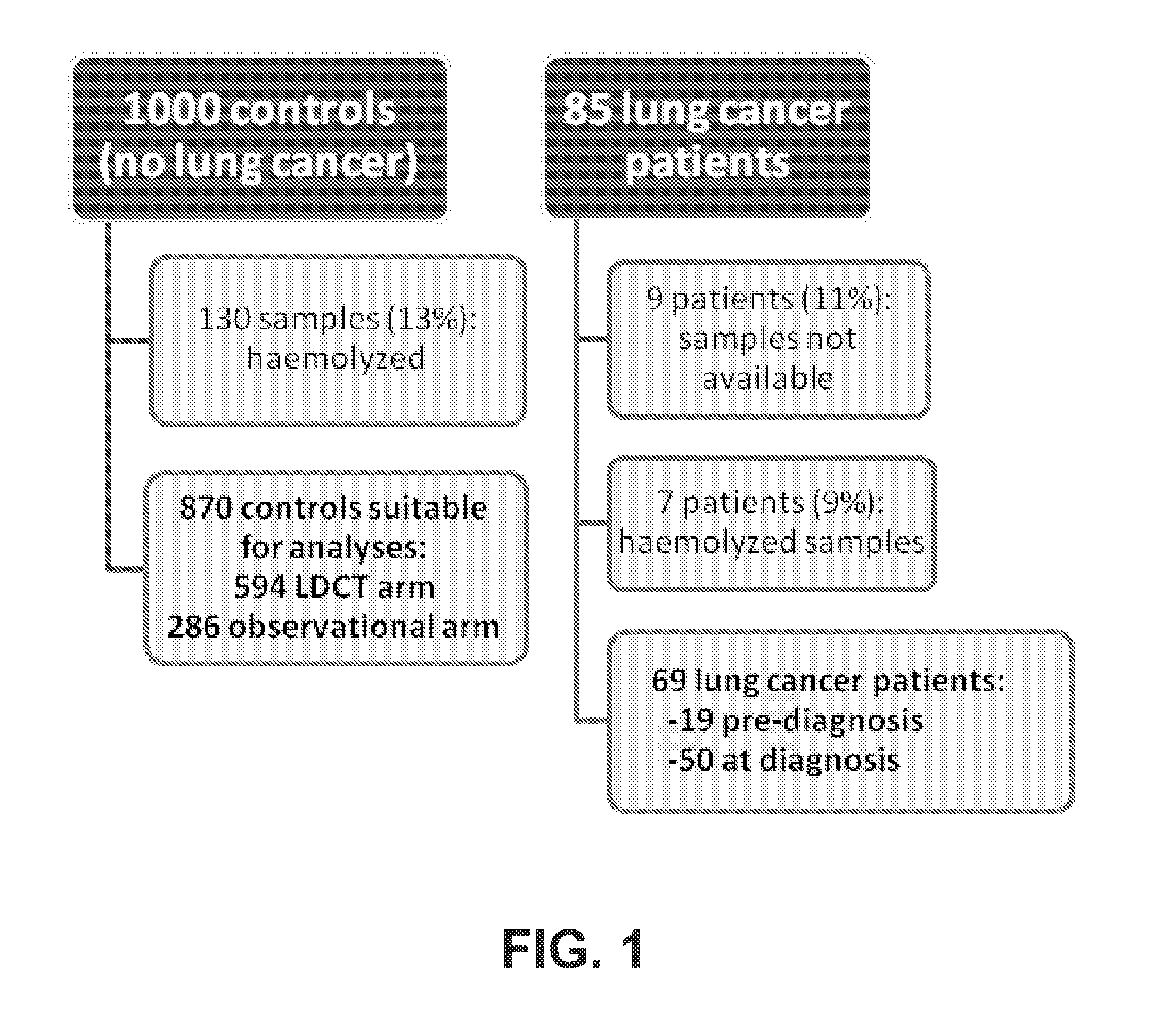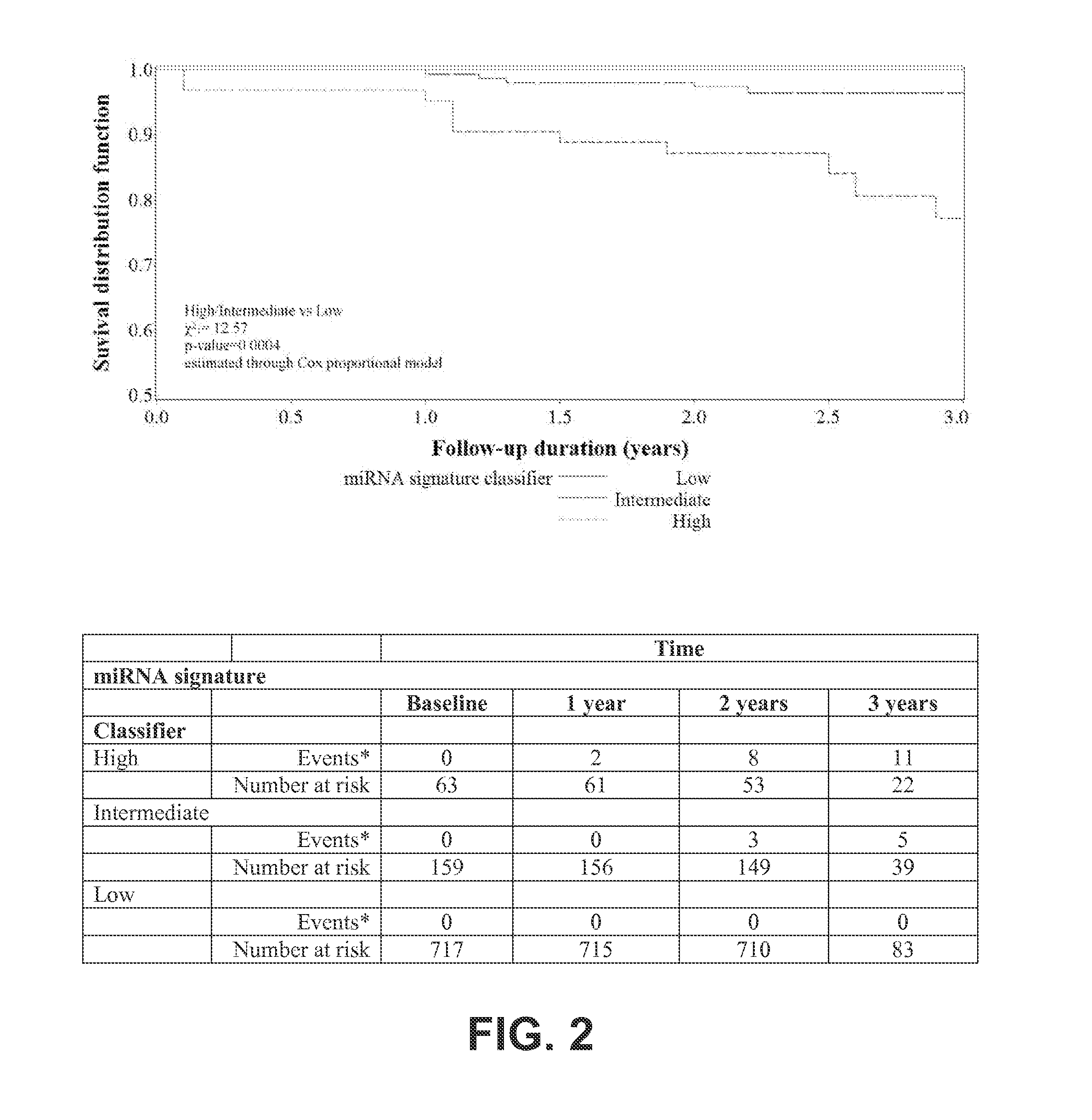Lung Cancer Determinations Using MIRNA
a technology of mirna and lung cancer, applied in the direction of biochemical equipment and processes, library screening, biocide, etc., can solve the problems of limited treatment efficacy and low survival ra
- Summary
- Abstract
- Description
- Claims
- Application Information
AI Technical Summary
Benefits of technology
Problems solved by technology
Method used
Image
Examples
example 1
Methods
[0254]A. Study Population.
[0255]The Multicentre Italian Lung Detection (MILD) trial, a randomized prospective clinical trial, was launched in 2005 and enrolled at the Istituto Nazionale dei Tumori of Milan 4,099 current or former smokers, at least 50 years old and without history of cancer within the prior five years: 2,376 (58%) were randomized to the LDCT arms (1190 annual, 1186 biennial LDCT) and 1,723 (42%) to the observational arm (Pastorino et al., 2012). At the time of enrollment (baseline) and of each annual or biennial recall of all volunteers of the trial, whole blood was collected as described (Boeri et al., 2011) according to the Internal Review and the Ethics Boards of the Istituto Nazionale dei Tumori of Milan.
[0256]For this study, 1,000 consecutive plasma samples collected from June 2009 to July 2010 among lung cancer-free individuals enrolled in the trial were used to determine the specificity of the MSC. Plasma samples were first assayed for hemolysis (see be...
example 2
Diagnostic and Prognostic Performance of MSC
[0292]Evaluable plasma samples obtained prior to or at diagnosis from 939 subjects across LDCT and observational arms were analyzed using a real-time RT-PCR based assay with a pre-specified MSC algorithm of Low, Intermediate and High risk of cancer groups. MSC risk groups were examined for all 939 subjects according to lung cancer occurrence, lung cancer death, and tumor stage (Table 11). MSC Intermediate and High correctly classified 60 of 69 lung cancer patients with 87% SE, 81% SP, 27% PPV and 99% NPV. Of the 19 lung cancer patients that died during follow-up, 18 were positive at the MSC test, with 95% SE, 81% SP, 10% PPV and 100% NPV. No deaths due to causes other than lung cancer were observed during the follow-up. Comparative diagnostic performance of MSC for lung cancer detection within the two arms was similar with 88% SE, 80% SP, 31% PPV, 99% NPV and 82% SE, 83% SP, 16% PPV, 99% NPV for LDCT and Observational arms respectively.
TAB...
example 3
Complementary Diagnostic Performance of LDCT and MSC
[0295]Restricting the analysis to the total of 652 subjects in the LDCT arm, LDCT identified 46 of 58 lung cancer subjects missing 3 patients within the 251 subjects with no pulmonary nodule detected and 9 patients because of an interval cancer for a SE of 79% (Table 13). The three cancers with “no pulmonary nodule” comprised of one non-solid lesion, one mediastinal adenopathy, and one pleural effusion. Pre-specified binary risk groups of MSC (considering High and Intermediate versus Low) identified 40 of 46 LDCT-detected cancers, 8 of 9 interval cancers and all 3 subjects with “no pulmonary nodule”.
TABLE 13Distribution of 939 subjects according to miRNA signature classifier (MSC) and low-dose computedtomography (LDCT), by LDCT (including screen-detected and non-screen detected lung cancers) and Observational arms. The Multicentric Italian Lung Detection (MILD) study, 2005-2012.No lung cancerLung cancerMSCMSCTOTALOverallHighInterme...
PUM
| Property | Measurement | Unit |
|---|---|---|
| Ratio | aaaaa | aaaaa |
| Biological properties | aaaaa | aaaaa |
| Level | aaaaa | aaaaa |
Abstract
Description
Claims
Application Information
 Login to View More
Login to View More - R&D
- Intellectual Property
- Life Sciences
- Materials
- Tech Scout
- Unparalleled Data Quality
- Higher Quality Content
- 60% Fewer Hallucinations
Browse by: Latest US Patents, China's latest patents, Technical Efficacy Thesaurus, Application Domain, Technology Topic, Popular Technical Reports.
© 2025 PatSnap. All rights reserved.Legal|Privacy policy|Modern Slavery Act Transparency Statement|Sitemap|About US| Contact US: help@patsnap.com


